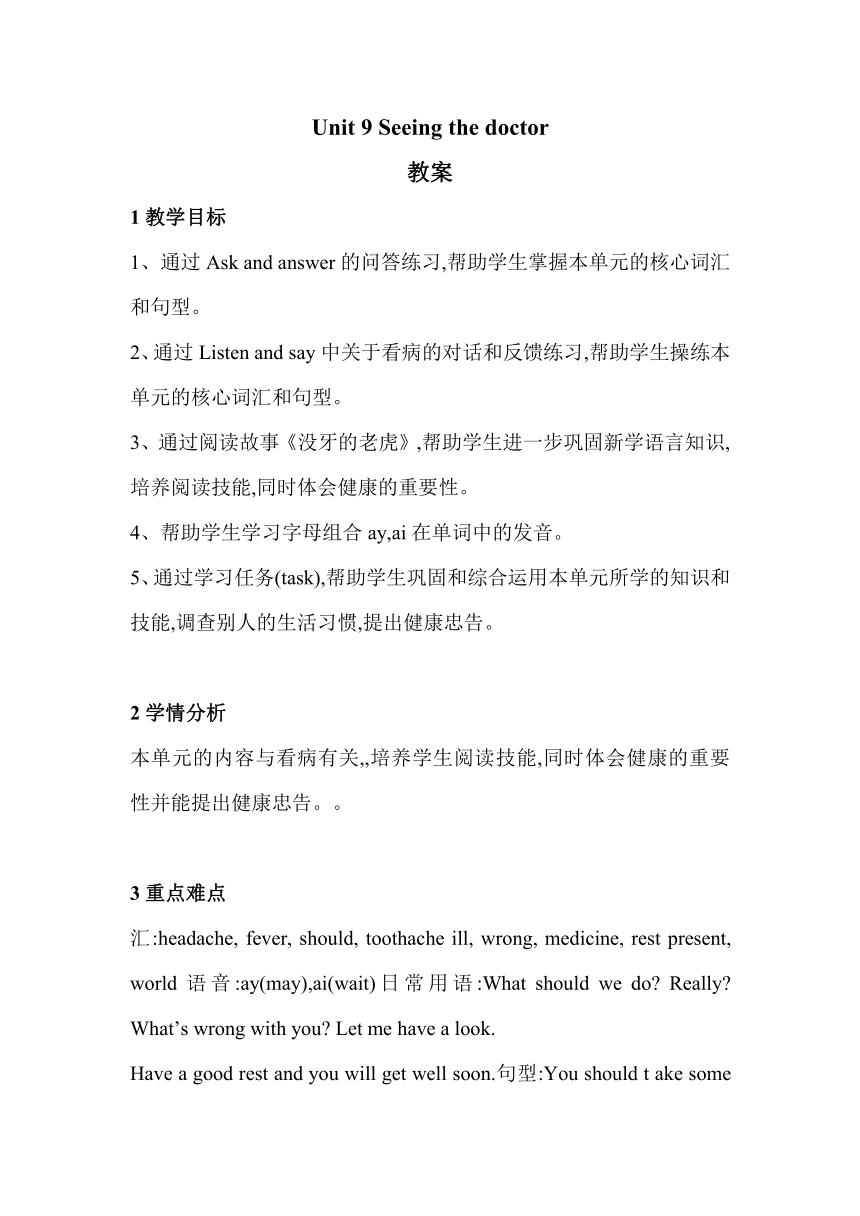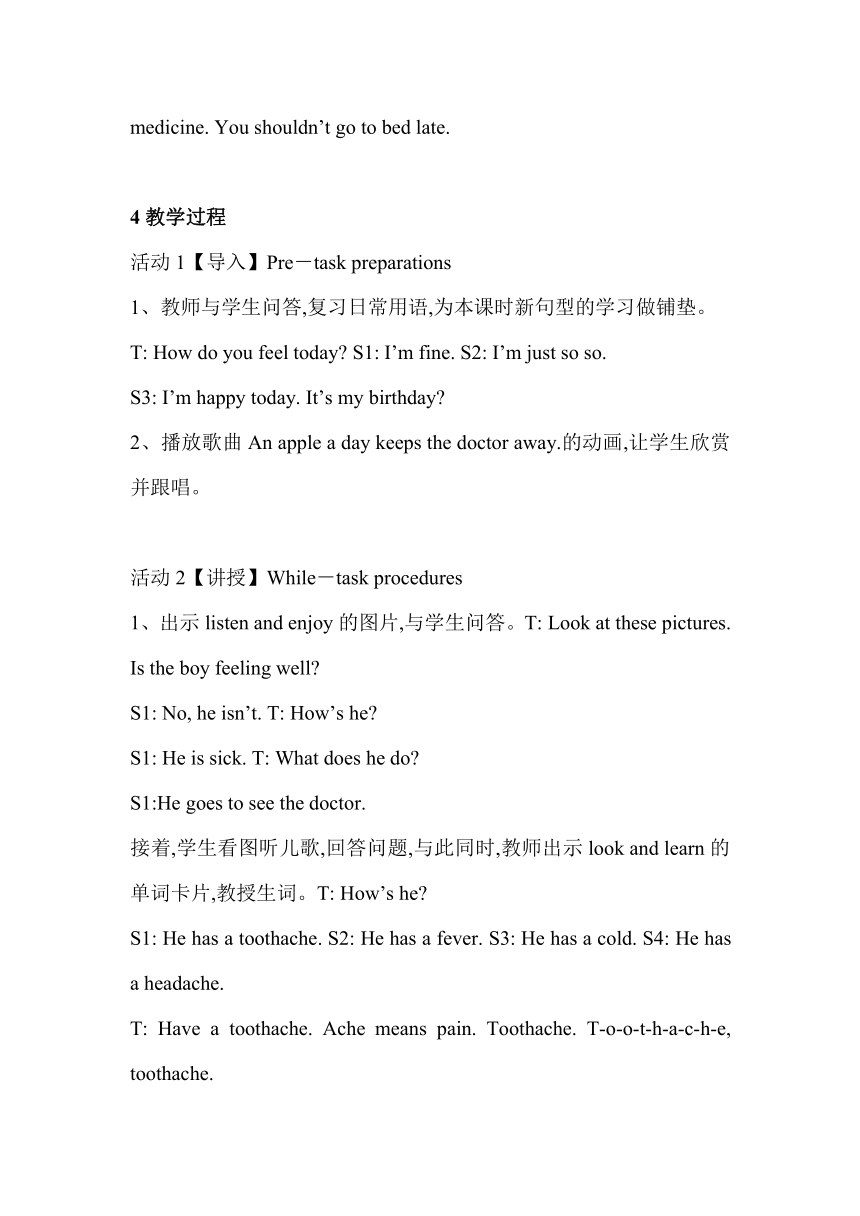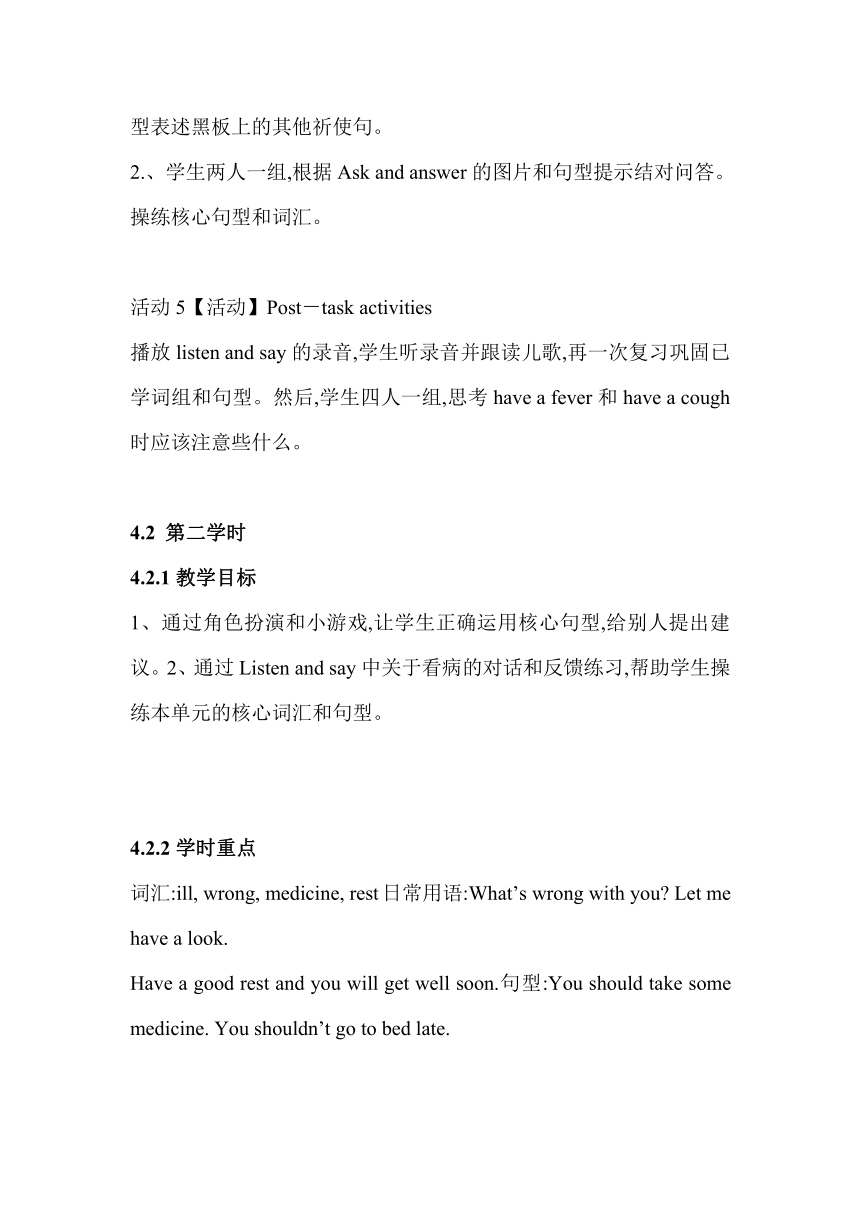Unit 9 Seeing the doctor 教案(3个课时)
文档属性
| 名称 | Unit 9 Seeing the doctor 教案(3个课时) |

|
|
| 格式 | zip | ||
| 文件大小 | 120.8KB | ||
| 资源类型 | 教案 | ||
| 版本资源 | 牛津沪教版 | ||
| 科目 | 英语 | ||
| 更新时间 | 2017-06-16 09:59:53 | ||
图片预览




文档简介
Unit
9
Seeing
the
doctor
教案
1教学目标
1、通过Ask
and
answer的问答练习,帮助学生掌握本单元的核心词汇和句型。
2、通过Listen
and
say中关于看病的对话和反馈练习,帮助学生操练本单元的核心词汇和句型。
3、通过阅读故事《没牙的老虎》,帮助学生进一步巩固新学语言知识,培养阅读技能,同时体会健康的重要性。
4、帮助学生学习字母组合ay,ai在单词中的发音。
5、通过学习任务(task),帮助学生巩固和综合运用本单元所学的知识和技能,调查别人的生活习惯,提出健康忠告。
2学情分析
本单元的内容与看病有关,,培养学生阅读技能,同时体会健康的重要性并能提出健康忠告。。
3重点难点
汇:headache,
fever,
should,
toothache
ill,
wrong,
medicine,
rest
present,
world语音:ay(may),ai(wait)日常用语:What
should
we
do
Really
What’s
wrong
with
you
Let
me
have
a
look.
Have
a
good
rest
and
you
will
get
well
soon.句型:You
should
t
ake
some
medicine.
You
shouldn’t
go
to
bed
late.
4教学过程
活动1【导入】Pre-task
preparations
1、教师与学生问答,复习日常用语,为本课时新句型的学习做铺垫。
T:
How
do
you
feel
today
S1:
I’m
fine.
S2:
I’m
just
so
so.
S3:
I’m
happy
today.
It’s
my
birthday
2、播放歌曲An
apple
a
day
keeps
the
doctor
away.的动画,让学生欣赏并跟唱。
活动2【讲授】While-task
procedures
1、出示listen
and
enjoy的图片,与学生问答。T:
Look
at
these
pictures.
Is
the
boy
feeling
well
S1:
No,
he
isn’t.
T:
How’s
he
S1:
He
is
sick.
T:
What
does
he
do
S1:He
goes
to
see
the
doctor.
接着,学生看图听儿歌,回答问题,与此同时,教师出示look
and
learn的单词卡片,教授生词。T:
How’s
he
S1:
He
has
a
toothache.
S2:
He
has
a
fever.
S3:
He
has
a
cold.
S4:
He
has
a
headache.
T:
Have
a
toothache.
Ache
means
pain.
Toothache.
T-o-o-t-h-a-c-h-e,
toothache.
Ss:
Toothache.
T-o-o-t-h-a-c-h-e,
toothache.然后教师用同样的方法教授短语have
a
fever,
have
a
cold,
have
a
headache。最后,教师将这些图片拿在手中,任意选出一张,让学生快速说出短语,以巩固记忆。
活动3【练习】While-task
procedures
学生以小组形式讨论listen
and
enjoy中男孩牙疼的原因。然后,学生说说讨论的结果。教师可先与一名学生对话,作为示范。
T:
Why
does
the
boy
have
a
toothache
S1:
He
doesn’t
brush
his
teeth.
T:
How
many
times
do
you
brush
your
teeth
every
day
S1:
I
brush
my
teeth
twice
a
day.
T:
Oh.
He
should
brush
his
teeth
twice
a
day.
S2:
He
eats
too
much
candy.
活动4【测试】While-task
procedures
1、引导学生用...should/shouldn’t...句型给男孩提出建议,并将核心句型板书在黑板上。
T:
The
boy
has
a
toothache,
because
he
doesn’t
brush
his
teeth
twice
a
day.
We
can
say
“Please
brush
your
teeth
twice
a
day.”
We
can
also
say”
You
should
brush
your
teeth
twice
a
day.”
Ss:
You
should
brush
your
teeth
twice
a
day.
T:
Don’t
eat
too
much
candy.
We
can
also
say
“you
shouldn’t
eat
too
much
candy.”
Ss:
You
shouldn’t
eat
too
much
candy.请学生用...should/shouldn’t...句型表述黑板上的其他祈使句。
2.、学生两人一组,根据Ask
and
answer的图片和句型提示结对问答。操练核心句型和词汇。
活动5【活动】Post-task
activities
播放listen
and
say的录音,学生听录音并跟读儿歌,再一次复习巩固已学词组和句型。然后,学生四人一组,思考have
a
fever和have
a
cough时应该注意些什么。
4.2
第二学时
4.2.1教学目标
1、通过角色扮演和小游戏,让学生正确运用核心句型,给别人提出建议。2、通过Listen
and
say中关于看病的对话和反馈练习,帮助学生操练本单元的核心词汇和句型。
4.2.2学时重点
词汇:ill,
wrong,
medicine,
rest日常用语:What’s
wrong
with
you
Let
me
have
a
look.
Have
a
good
rest
and
you
will
get
well
soon.句型:You
should
take
some
medicine.
You
shouldn’t
go
to
bed
late.
4.2.3学时难点
词汇:ill,
wrong,
medicine
,rest日常用语:What’s
wrong
with
you
Let
me
have
a
look.
Have
a
good
rest
and
you
will
get
well
soon.句型:You
should
take
some
medicine.
You
shouldn’t
go
to
bed
late.
4.2.4教学活动
活动1【导入】Pre-task
preparations
学生听录音跟读listen
and
enjoy的儿歌,然后回答有关儿歌内容的问题。
T:
The
boy
has
a
toothache.
What
do
you
want
to
say
to
him
S1:
You
should
brush
your
teeth
twice
a
day.
S2:
You
shouldn’t
eat
too
many
cakes....
T:
The
boy
has
a
fever.
What
do
you
want
to
say
to
him
S1:
You
should
drink
a
lot
of
water.
S2:
you
shouldn’t
go
out
and
play...
活动2【测试】While-task
procedures
1、播放listen
and
say的录音,出示以下问题,让学生听录音后回答问题。
1)
How
does
Kitty
feel
2)
Where
does
she
go
2、再次播放录音,学生听对话,找出医生是如何提问的。
T:
What
does
the
doctor
say
S1:
What
is
wrong
with
you
然后,学生两人一组,分别扮演医生和病人,利用图片进行问答,操练句型。
S1:
I
am
not
feeling
well.
S2:
What
is
wrong
with
you
S1:
I
have
a
fever.
活动3【练习】While-task
procedures
学生朗读对话,列出医生给予的建议。然后,请几名学生扮演医生给Kitty一些建议,同时学习对话中的生词、
短语和日常用语。
S1:
You
have
a
cold.
You
should
take
some
medicine.
You
should
drink
a
lot
of
water
and
have
a
good
rest.
You
will
get
well
soon.
T:
Take
some
medicine.
Medicine.
M-e-d-i-c-i-n-e,
medicine.
Ss:
Medicine.
M-e-d-i-c-i-n-e,
medicine.
T:rest.
R-e-s-t.rest.Havearest.Ss:rest.R-e-s-t.rest.Havearest....
然后,让学生完成课本第59页的反馈练习,填空完成Kitty的日记,全班一起核对答案。
活动4【活动】Post-task
activities
学生两人一组,分别扮演医生和病人,模仿课文改编对话并表演。
4.3
第三学时
4.3.1教学目标
1、通过阅读故事《没牙的老虎》,帮助学生进一步巩固新学语言知识,培养
阅读技能,同时体会健康的重要性。
2、帮助学生学习字母组合ay,
ai在单词中的发音。
3、通过学习任务(task),帮助学生巩固和综合运用本单元所学的知识和技
能,调查别人的生活习惯,提出健康忠告。
4.3.2学时重点
词汇:present,
world语音:ay(may),ai(wait)日常用语:What
should
we
do
Really
4.3.3学时难点
词汇:present,
world语音:ay(may),ai(wait)日常用语:What
should
we
do
Really
4.3.4教学活动
活动1【导入】Pre-task
preparations
1、学生朗读listen
and
enjoy的儿歌,巩固学生配上动作和相应表情,请个别学生上来表演。
2、出示谜语,通过猜谜活动引出Read
a
story故事中的动物。
(Show
the
riddles
to
the
class)
Read
and
guess
the
riddles
in
pairs.
Riddle1:
It
is
small.
It
is
white.
It
has
two
red
eyes,
two
long
ears
and
a
short
tail.
Carrots
are
its
favourite
food.
What
is
it
Riddle
2:
It
is
small.
It
is
brown.
It
has
a
long
tail.
It
can
climb
trees.
Bananas
are
its
favourite
food.
What
is
it
Riddle3:
It
is
big
and
tall.
It
has
many
stripes.
It
looks
like
a
horse.
It
can
run
fast.
What
is
it
Riddle4:
It
looks
like
a
cat.
But
it
is
big
and
strong.
It
is
the
king
of
the
forest.
All
the
other
animals
are
afraid
of
it.
What
is
it
S1:It
is
a
rabbit.
S2:
It
is
a
monkey.
S3:
it
is
a
zebra.
S4:
It
is
a
tiger.
活动2【活动】While-task
procedures
1、出示read
a
story的图1,与学生问答。T:
How
many
animals
do
you
see
What
are
they
S1:
Five.
They
are
a
tiger,
a
monkey,
a
rabbit,
a
zebra
and
a...
T:
This
is
a
squirrel.
Say
after
me.
S-q-u-i-r-r-e-l,
squirrel.
Ss:
S-q-u-i-r-r-e-l,
squirrel.
然后,播放故事第一段的录音,接着,询问学生听到的信息。
T:
Who
is
the
king
of
the
forest
Do
the
animals
like
him
S1:
The
tiger
is
the
king
of
the
forest.
The
animals
don’t
like
the
tiger.
They
are
afraid
of
him.再次播放录音,并要求学生模仿和分角色扮演。1)
The
zebra
has
a
good
idea.
()
2)
The
fox
gives
the
tiger
a
lot
of
books.
()
3)
The
tiger
has
a
toothache.
()
4)At
last,
the
tiger
cannot
eat
other
animals.通过师生问答,在核对答案的过程中帮助学生初步了解故事内容,学习相关词汇。
2、出示下列问题,引导学生读故事,寻找答案。
1)
Who
are
the
animals
afraid
of
2)
What
does
the
fox
give
the
tiger
3)
What
gives
the
tiger
a
toothache
4)
How
do
the
animals
help
the
tiger
活动3【练习】While-task
procedures
1.围绕第四副图片和故事中动物角色的特点,引导学生拓展情境,展开合理想象。
2、出示Learn
the
sounds的语音单词卡片ay(may),ai(wait),请学生跟读并感受字母组合ay,
ai在单词中的发音。
教师播放录音,学生跟着录音朗读。播放录音,学生按照录音节拍诵读儿歌。
教师朗读单词,学生在多个单词中找出教师所读单词。
活动4【作业】Post-task
activities
让学生根据练习册中task的发展图片和句型提示与学生问答,调查同学的生活习惯,然后根据问答所得信息填写调查表。最后,作为回家作业,让学生完成think
and
write,给一个同学写一份健康忠告。
9
Seeing
the
doctor
教案
1教学目标
1、通过Ask
and
answer的问答练习,帮助学生掌握本单元的核心词汇和句型。
2、通过Listen
and
say中关于看病的对话和反馈练习,帮助学生操练本单元的核心词汇和句型。
3、通过阅读故事《没牙的老虎》,帮助学生进一步巩固新学语言知识,培养阅读技能,同时体会健康的重要性。
4、帮助学生学习字母组合ay,ai在单词中的发音。
5、通过学习任务(task),帮助学生巩固和综合运用本单元所学的知识和技能,调查别人的生活习惯,提出健康忠告。
2学情分析
本单元的内容与看病有关,,培养学生阅读技能,同时体会健康的重要性并能提出健康忠告。。
3重点难点
汇:headache,
fever,
should,
toothache
ill,
wrong,
medicine,
rest
present,
world语音:ay(may),ai(wait)日常用语:What
should
we
do
Really
What’s
wrong
with
you
Let
me
have
a
look.
Have
a
good
rest
and
you
will
get
well
soon.句型:You
should
t
ake
some
medicine.
You
shouldn’t
go
to
bed
late.
4教学过程
活动1【导入】Pre-task
preparations
1、教师与学生问答,复习日常用语,为本课时新句型的学习做铺垫。
T:
How
do
you
feel
today
S1:
I’m
fine.
S2:
I’m
just
so
so.
S3:
I’m
happy
today.
It’s
my
birthday
2、播放歌曲An
apple
a
day
keeps
the
doctor
away.的动画,让学生欣赏并跟唱。
活动2【讲授】While-task
procedures
1、出示listen
and
enjoy的图片,与学生问答。T:
Look
at
these
pictures.
Is
the
boy
feeling
well
S1:
No,
he
isn’t.
T:
How’s
he
S1:
He
is
sick.
T:
What
does
he
do
S1:He
goes
to
see
the
doctor.
接着,学生看图听儿歌,回答问题,与此同时,教师出示look
and
learn的单词卡片,教授生词。T:
How’s
he
S1:
He
has
a
toothache.
S2:
He
has
a
fever.
S3:
He
has
a
cold.
S4:
He
has
a
headache.
T:
Have
a
toothache.
Ache
means
pain.
Toothache.
T-o-o-t-h-a-c-h-e,
toothache.
Ss:
Toothache.
T-o-o-t-h-a-c-h-e,
toothache.然后教师用同样的方法教授短语have
a
fever,
have
a
cold,
have
a
headache。最后,教师将这些图片拿在手中,任意选出一张,让学生快速说出短语,以巩固记忆。
活动3【练习】While-task
procedures
学生以小组形式讨论listen
and
enjoy中男孩牙疼的原因。然后,学生说说讨论的结果。教师可先与一名学生对话,作为示范。
T:
Why
does
the
boy
have
a
toothache
S1:
He
doesn’t
brush
his
teeth.
T:
How
many
times
do
you
brush
your
teeth
every
day
S1:
I
brush
my
teeth
twice
a
day.
T:
Oh.
He
should
brush
his
teeth
twice
a
day.
S2:
He
eats
too
much
candy.
活动4【测试】While-task
procedures
1、引导学生用...should/shouldn’t...句型给男孩提出建议,并将核心句型板书在黑板上。
T:
The
boy
has
a
toothache,
because
he
doesn’t
brush
his
teeth
twice
a
day.
We
can
say
“Please
brush
your
teeth
twice
a
day.”
We
can
also
say”
You
should
brush
your
teeth
twice
a
day.”
Ss:
You
should
brush
your
teeth
twice
a
day.
T:
Don’t
eat
too
much
candy.
We
can
also
say
“you
shouldn’t
eat
too
much
candy.”
Ss:
You
shouldn’t
eat
too
much
candy.请学生用...should/shouldn’t...句型表述黑板上的其他祈使句。
2.、学生两人一组,根据Ask
and
answer的图片和句型提示结对问答。操练核心句型和词汇。
活动5【活动】Post-task
activities
播放listen
and
say的录音,学生听录音并跟读儿歌,再一次复习巩固已学词组和句型。然后,学生四人一组,思考have
a
fever和have
a
cough时应该注意些什么。
4.2
第二学时
4.2.1教学目标
1、通过角色扮演和小游戏,让学生正确运用核心句型,给别人提出建议。2、通过Listen
and
say中关于看病的对话和反馈练习,帮助学生操练本单元的核心词汇和句型。
4.2.2学时重点
词汇:ill,
wrong,
medicine,
rest日常用语:What’s
wrong
with
you
Let
me
have
a
look.
Have
a
good
rest
and
you
will
get
well
soon.句型:You
should
take
some
medicine.
You
shouldn’t
go
to
bed
late.
4.2.3学时难点
词汇:ill,
wrong,
medicine
,rest日常用语:What’s
wrong
with
you
Let
me
have
a
look.
Have
a
good
rest
and
you
will
get
well
soon.句型:You
should
take
some
medicine.
You
shouldn’t
go
to
bed
late.
4.2.4教学活动
活动1【导入】Pre-task
preparations
学生听录音跟读listen
and
enjoy的儿歌,然后回答有关儿歌内容的问题。
T:
The
boy
has
a
toothache.
What
do
you
want
to
say
to
him
S1:
You
should
brush
your
teeth
twice
a
day.
S2:
You
shouldn’t
eat
too
many
cakes....
T:
The
boy
has
a
fever.
What
do
you
want
to
say
to
him
S1:
You
should
drink
a
lot
of
water.
S2:
you
shouldn’t
go
out
and
play...
活动2【测试】While-task
procedures
1、播放listen
and
say的录音,出示以下问题,让学生听录音后回答问题。
1)
How
does
Kitty
feel
2)
Where
does
she
go
2、再次播放录音,学生听对话,找出医生是如何提问的。
T:
What
does
the
doctor
say
S1:
What
is
wrong
with
you
然后,学生两人一组,分别扮演医生和病人,利用图片进行问答,操练句型。
S1:
I
am
not
feeling
well.
S2:
What
is
wrong
with
you
S1:
I
have
a
fever.
活动3【练习】While-task
procedures
学生朗读对话,列出医生给予的建议。然后,请几名学生扮演医生给Kitty一些建议,同时学习对话中的生词、
短语和日常用语。
S1:
You
have
a
cold.
You
should
take
some
medicine.
You
should
drink
a
lot
of
water
and
have
a
good
rest.
You
will
get
well
soon.
T:
Take
some
medicine.
Medicine.
M-e-d-i-c-i-n-e,
medicine.
Ss:
Medicine.
M-e-d-i-c-i-n-e,
medicine.
T:rest.
R-e-s-t.rest.Havearest.Ss:rest.R-e-s-t.rest.Havearest....
然后,让学生完成课本第59页的反馈练习,填空完成Kitty的日记,全班一起核对答案。
活动4【活动】Post-task
activities
学生两人一组,分别扮演医生和病人,模仿课文改编对话并表演。
4.3
第三学时
4.3.1教学目标
1、通过阅读故事《没牙的老虎》,帮助学生进一步巩固新学语言知识,培养
阅读技能,同时体会健康的重要性。
2、帮助学生学习字母组合ay,
ai在单词中的发音。
3、通过学习任务(task),帮助学生巩固和综合运用本单元所学的知识和技
能,调查别人的生活习惯,提出健康忠告。
4.3.2学时重点
词汇:present,
world语音:ay(may),ai(wait)日常用语:What
should
we
do
Really
4.3.3学时难点
词汇:present,
world语音:ay(may),ai(wait)日常用语:What
should
we
do
Really
4.3.4教学活动
活动1【导入】Pre-task
preparations
1、学生朗读listen
and
enjoy的儿歌,巩固学生配上动作和相应表情,请个别学生上来表演。
2、出示谜语,通过猜谜活动引出Read
a
story故事中的动物。
(Show
the
riddles
to
the
class)
Read
and
guess
the
riddles
in
pairs.
Riddle1:
It
is
small.
It
is
white.
It
has
two
red
eyes,
two
long
ears
and
a
short
tail.
Carrots
are
its
favourite
food.
What
is
it
Riddle
2:
It
is
small.
It
is
brown.
It
has
a
long
tail.
It
can
climb
trees.
Bananas
are
its
favourite
food.
What
is
it
Riddle3:
It
is
big
and
tall.
It
has
many
stripes.
It
looks
like
a
horse.
It
can
run
fast.
What
is
it
Riddle4:
It
looks
like
a
cat.
But
it
is
big
and
strong.
It
is
the
king
of
the
forest.
All
the
other
animals
are
afraid
of
it.
What
is
it
S1:It
is
a
rabbit.
S2:
It
is
a
monkey.
S3:
it
is
a
zebra.
S4:
It
is
a
tiger.
活动2【活动】While-task
procedures
1、出示read
a
story的图1,与学生问答。T:
How
many
animals
do
you
see
What
are
they
S1:
Five.
They
are
a
tiger,
a
monkey,
a
rabbit,
a
zebra
and
a...
T:
This
is
a
squirrel.
Say
after
me.
S-q-u-i-r-r-e-l,
squirrel.
Ss:
S-q-u-i-r-r-e-l,
squirrel.
然后,播放故事第一段的录音,接着,询问学生听到的信息。
T:
Who
is
the
king
of
the
forest
Do
the
animals
like
him
S1:
The
tiger
is
the
king
of
the
forest.
The
animals
don’t
like
the
tiger.
They
are
afraid
of
him.再次播放录音,并要求学生模仿和分角色扮演。1)
The
zebra
has
a
good
idea.
()
2)
The
fox
gives
the
tiger
a
lot
of
books.
()
3)
The
tiger
has
a
toothache.
()
4)At
last,
the
tiger
cannot
eat
other
animals.通过师生问答,在核对答案的过程中帮助学生初步了解故事内容,学习相关词汇。
2、出示下列问题,引导学生读故事,寻找答案。
1)
Who
are
the
animals
afraid
of
2)
What
does
the
fox
give
the
tiger
3)
What
gives
the
tiger
a
toothache
4)
How
do
the
animals
help
the
tiger
活动3【练习】While-task
procedures
1.围绕第四副图片和故事中动物角色的特点,引导学生拓展情境,展开合理想象。
2、出示Learn
the
sounds的语音单词卡片ay(may),ai(wait),请学生跟读并感受字母组合ay,
ai在单词中的发音。
教师播放录音,学生跟着录音朗读。播放录音,学生按照录音节拍诵读儿歌。
教师朗读单词,学生在多个单词中找出教师所读单词。
活动4【作业】Post-task
activities
让学生根据练习册中task的发展图片和句型提示与学生问答,调查同学的生活习惯,然后根据问答所得信息填写调查表。最后,作为回家作业,让学生完成think
and
write,给一个同学写一份健康忠告。
同课章节目录
- Module 1 Changes and differences
- Unit 1 Tidy up!
- Unit 2 Our new home
- Unit 3 In the future
- Module 2 Work and play
- Unit 4 Reading is fun
- Unit 5 At the weekend
- Unit 6 Holidays
- Module 3 Things we do
- Unit 7 Open day
- Unit 8 Buying clothes
- Unit 9 Seeing the doctor
- Module 4 Things we enjoy
- Unit 10 Great inventions
- Unit 11 Chinese festivals
- Unit 12 The giant's garden
